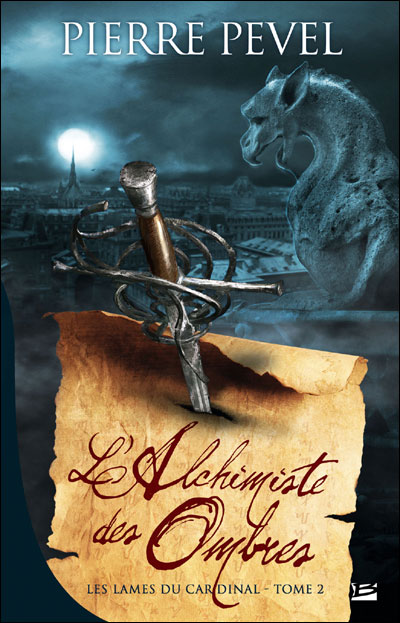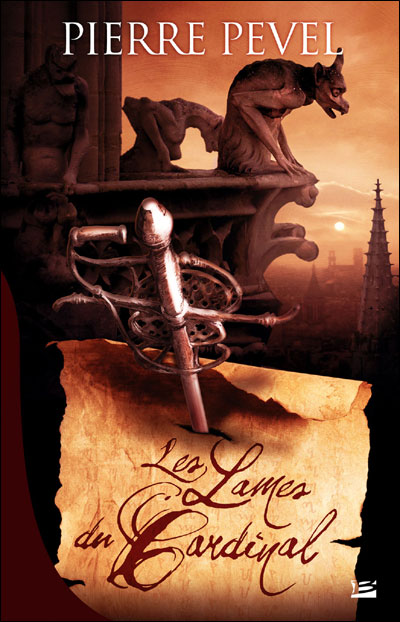88
Je préfère ce type de couve plus sobre que l'illu moche du premier volume.Ceci étant le premier était un bon petit récit de cape et d'épées mâtiné de fantastique et d'intrigue de cours fort sympathique et rondement mené. Sans prétention aucune, mais qui divertit grandement. Je pense que je me fendrais d'une lecture du deuxième^^
94
J'ai beaucoup aimé les deux tomes. Je viens de finir la série des mousquetaires (Les trois mousquetaires, Vingt ans après et le Vicomte de Bragelonne) de Dumas, et je trouve que Pevel parvient vraiment à faire revivre cette ambiance. C'est plus que de l'historique mâtiné de fantasy ; là c'est même Alexandre Dumas à la sauce fantasy. Le rêve, quoi - pas vraiment de défauts à signaler dans ces deux tomes. Richelieu qui écrit avec sur son bureau un dragonnet pourpre qui dort enroulé sur lui-même : ça c'est une image qui fait rêver! Ça aurait été une bonne couverture aussi, tiens - genre faite par Graffet.
95
J'ai fini ce premier tome et c'est tout bonnement excellent. :)Les derniers chapitres laissent entrevoir un deuxième tome digne de ce nom ! :)Ce roman est génial: historique et original pour de la fantasy. ;)Ce qui est impressionnant, ce sont tout les retournement de situation, et toutes ces intrigues !  :)Au final, on ne peut que conseiller ce roman.L'Alchimiste des Ombres sera sans nul doute sous le sapin ! :pTout à fait d'accord Linaka pour Richelieu et son dragonnet !
:)Au final, on ne peut que conseiller ce roman.L'Alchimiste des Ombres sera sans nul doute sous le sapin ! :pTout à fait d'accord Linaka pour Richelieu et son dragonnet !  Ca aurait fait une belle couverture.
Ca aurait fait une belle couverture. 
96
Marrant de découvrir une critique du roman... en anglais, pour la sortie de la traduction. 
fantasy book critic a écrit :November 19, 2009 marks the UK Hardcover & Trade Paperback publication of “The Cardinal’s Blades” via Gollancz. The English version was translated by Tom Clegg. The original French version was published in 2007 by Braglonne.ANALYSIS: If Alexandre Dumas had written a fantasy novel, it would probably look something like Pierre Pevel’s “The Cardinal’s Blades”, which takes Dumas' swashbuckling adventure, intrigue and historical setting, and adds dragons to the mix—think The Three Musketeers meets Naomi Novik’s Temeraire. A cool concept in theory, but does it work? Well, yes and no...On the plus side, “The Cardinal’s Blades” is a lot of fun to read. The action, as promised, is non-stop, driven by short 3-4 page long chapters and multiple subplots; the intrigue is engaging and devious, full of little twists and turns with nearly every character in the book harboring a secret of some sort or hidden allegiance; the cast of characters is extensive, diverse and likeable; humor is light and enjoyable; and some familiar faces appear in the book including Cardinal Richelieu, Comte de Rochefort, and even AthosIn short, “The Cardinal’s Blades” successfully captures the spirit of Alexandre Dumas, and should immediately appeal to anyone who is a fan of swashbuckling adventure.Fantasy lovers however, are not quite as lucky. For while the historical, swashbuckling and intrigue aspects are handled beautifully, the fantasy elements in the book are drastically understated. Yes, there are dragons and magic in “The Cardinal’s Blades” in the form of the Black Claw order, wyverns (racial cousins of the dragons who serve mankind as winged mounts), half-bloods, dragonnets (used as pets or messengers), dracs (a race spawned by the dragons in order to serve them), the ranse disease (originated from dragons), and a Sphère d’ Áme (houses the soul of an Ancestral Dragon), but so little time is spent on fleshing out these elements—a few paragraphs here and there—that they feel more like garnish than an integral part of the novel. This problem also extends to the story which primarily focuses on the machinations between France, Spain, the Cardinal’s Blades and the Black Claw, as opposed to the greater threat in the Court of Dragons. Basically, if the author had spent as much time and effort on developing the fantasy parts of the novel as he did the rest of the book, then “The Cardinal’s Blades” would have been profoundly better.Other problems with the book includes a plot that takes a long time to develop (nearly 180 pages before the Cardinal’s Blades are reformed and their mission revealed); the blunt manner in which the author spells out everything that is happening intrigue-wise, as if it would be too difficult for the reader to folllow—it’s not by the way; and the characterization, or lack thereof. Of the last, because there are so many characters in the novel and because the chapters are so short, very little character development is going on apart from establishing a few main traits: Marciac is roguish and a womanizer, Almades is serious and reserved, La Fargue is the grizzled leader, etc. As a result, it’s very hard to actually care about anyone in the book—they are mostly recognizable stock figures anyway—regardless of how fun their narratives may be. Finally, I found the prose to be surprisingly plain and economical, especially for an award-winning author, although that may be more due to the translation than Pierre Pevel’s actual writing style.CONCLUSION: In the end, Pierre Pevel’s “The Cardinal’s Blades” is a fast and fun reading experience, but is plagued by a few fundamental problems and lacks the substance and depth to be anything more than a good summer read. It’s also a book that I believe will appeal more to fans of Alexandre Dumas, swashbuckling adventures, and alternate histories than those of epic fantasies. Fortunately, being a fan of Dumas myself as well as fantasy, I enjoyed reading “The Cardinal’s Blades” and look forward to continuing the series...
98
Pevel sera aussi publié aux Etats-Unis, l'année prochaine, chez Pyr : http://pyrsf.blogspot.com/2009/12/more- ... ck-at.html 
100
Après avoir abandonné à son sort le Chevalier de Wieldstadt, et après nous avoir laissé sans nouvelle du mage Louis Denizart Hippolyte Griffont, cela serait vraiment triste qu'il n'ait pas de suite aux aventures des lames du cardinal (d'autant plus plus que le cliffhanger est cette fois-ci vraiment d'envergure !).Wait and see comme on dit !


